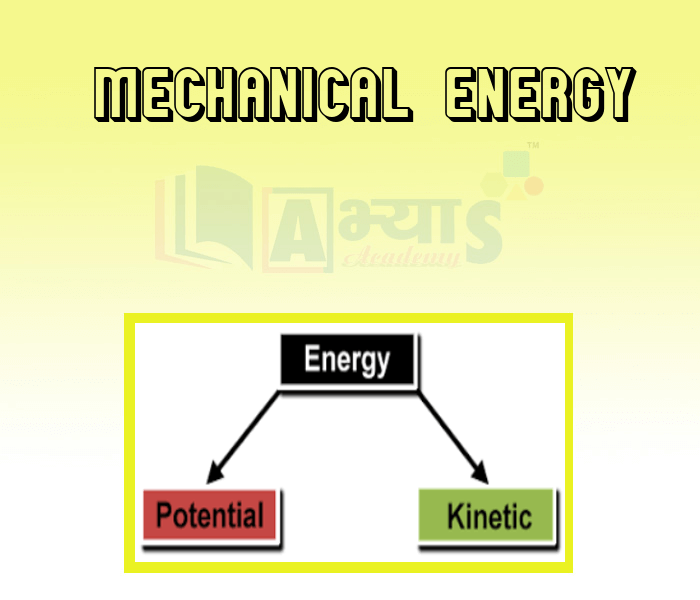Mechanical Energy












Mechanical Energy
Mechanical Energy
Energy in an object which can create some motion in the object is known as mechanical energy. Mechanical energy is the energy that is possessed by an object due to its motion or due to its position. There are two forms of mechanical energy that is kinetic energy (energy due to motion) or potential energy (energy due to the position). Mechanical energy of an object can be calculated as the sum of the kinetic energy and the potential energy of an object.
Kinetic energy :
Energy possessed by a body by virtue of its state of motion is called kinetic energy. A moving bus, a rolling ball are some examples of kinetic energy.
Potential energy :
Energy possessed by an object due to its position is called as potential energy. A stretched rubber band, a catapult are some examples of potential energy
For example :
The kinetic energy of an aeroplane at rest is zero. As the aeroplane is standing at the ground level its potential energy is zero on the ground. Then, its mechanical energy which is the sum of kinetic energy and potential energy is zero while it rests on the ground. When the same aeroplane flies, it has kinetic as well as potential energy. Their sum gives the aeroplane's mechanical energy in flight.
Conservation of Mechanical Energy :
The total mechanical energy of a system is conserved i.e. energy can neither be created nor destroyed , it can only be converted from one form to other.
K.E. + P.E. = constant
Which of the following statements are true 1. The kinetic energy of an aeroplane at rest is zero. 2. The aeroplane standing at the ground level has zero potential energy. 3. The mechanical energy of the aeroplane at rest will be zero
| |||
| Right Option : C | |||
| View Explanation | |||
An object possesses a mechanical energy of 620 J and kinetic energy of 130 J . The potential energy in an object will be _______________ | |||
| Right Option : C | |||
| View Explanation | |||
Which of the following are the example of potential energy. | |||
| Right Option : D | |||
| View Explanation | |||
Students / Parents Reviews [10]
It has a great methodology. Students here can get analysis to their test quickly.We can learn easily through PPTs and the testing methods are good. We know that where we have to practice

Barkha Arora
10thOne of the best institutes to develope a child interest in studies.Provides SST and English knowledge also unlike other institutes. Teachers are co operative and friendly online tests andPPT develope practical knowledge also.

Aman Kumar Shrivastava
10thIt was a good experience with Abhyas Academy. I even faced problems in starting but slowly and steadily overcomed. Especially reasoning classes helped me a lot.

Cheshta
10thAbhyas Methodology is very good. It is based on according to student and each child manages accordingly to its properly. Methodology has improved the abilities of students to shine them in future.

Manish Kumar
10thIt was good as the experience because as we had come here we had been improved in a such envirnment created here.Extra is taught which is beneficial for future.

Eshan Arora
8thMy experience with Abhyas is very good. I have learnt many things here like vedic maths and reasoning also. Teachers here first take our doubts and then there are assignments to verify our weak points.

Shivam Rana
7thA marvelous experience with Abhyas. I am glad to share that my ward has achieved more than enough at the Ambala ABHYAS centre. Years have passed on and more and more he has gained. May the centre flourish and develop day by day by the grace of God.

Archit Segal
7thMy experience with Abhyas academy is very good. I did not think that my every subject coming here will be so strong. The main thing is that the online tests had made me learn here more things.

Hiya Gupta
8thAbout Abhyas metholodology the teachers are very nice and hardworking toward students.The Centre Head Mrs Anu Sethi is also a brilliant teacher.Abhyas has taught me how to overcome problems and has always taken my doubts and suppoeted me.

Shreya Shrivastava
8thI have spent a wonderful time in Abhyas academy. It has made my reasoning more apt, English more stronger and Maths an interesting subject for me. It has given me a habbit of self studying
